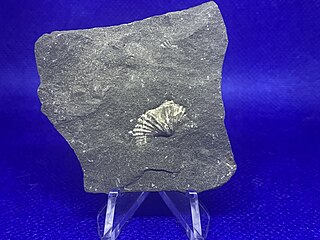
Tentaculites is an extinct genus of conical fossils of uncertain affinity, class Tentaculita, although it is not the only member of the class. It is known from Lower Ordovician to Upper Devonian deposits both as calcitic shells with a brachiopod-like microstructure and carbonaceous 'linings'. The "tentaculites" are also referred to as the styliolinids.

Mucrospirifer is a genus of extinct brachiopods in the class Rhynchonellata (Articulata) and the order Spiriferida. They are sometimes known as "butterfly shells". Like other brachiopods, they were filter feeders. These fossils occur mainly in Middle Devonian strata and appear to occur around the world, except in Australia and Antarctica.

Zapodidae, the jumping mice, is a family of mouse-like rodents in North America and China.

Latimeriidae is the only extant family of coelacanths, an ancient lineage of lobe-finned fish. It contains two extant species in the genus Latimeria, found in deep waters off the coasts of southern Africa and east-central Indonesia. In addition, several fossil genera are known from the Mesozoic of Europe, the Middle East, and the southeastern United States, dating back to the Triassic.
Dictyothyris is an extinct genus of brachiopods that lived from the Middle Jurassic to the Early Cretaceous throughout what is now Europe and North Africa.

Terebratula is a modern genus of brachiopods with a fossil record dating back to the Late Devonian. These brachiopods are stationary epifaunal suspension feeders and have a worldwide distribution.

Brachiopods, phylum Brachiopoda, are a phylum of trochozoan animals that have hard "valves" (shells) on the upper and lower surfaces, unlike the left and right arrangement in bivalve molluscs. Brachiopod valves are hinged at the rear end, while the front can be opened for feeding or closed for protection. Two major categories are traditionally recognized, articulate and inarticulate brachiopods. The word "articulate" is used to describe the tooth-and-groove structures of the valve-hinge which is present in the articulate group, and absent from the inarticulate group. This is the leading diagnostic skeletal feature, by which the two main groups can be readily distinguished as fossils. Articulate brachiopods have toothed hinges and simple, vertically-oriented opening and closing muscles. Conversely, inarticulate brachiopods have weak, untoothed hinges and a more complex system of vertical and oblique (diagonal) muscles used to keep the two valves aligned. In many brachiopods, a stalk-like pedicle projects from an opening near the hinge of one of the valves, known as the pedicle or ventral valve. The pedicle, when present, keeps the animal anchored to the seabed but clear of sediment which would obstruct the opening.

Anomia is a genus of saltwater clams, marine bivalve mollusks in the family Anomiidae. They are commonly known as jingle shells because when a handful of them are shaken they make a jingling sound, though some are also known as saddle oysters.

Gigantoproductus giganteus is an extinct species of brachiopods in the family Monticuliferidae, known only from its fossil remains. It was a marine invertebrate found on the seabed in shallow seas. It evolved during the Carboniferous period and it is believed to be the largest brachiopod that has ever existed.

Sphenorhynchia plicatella is an extinct species of brachiopods belonging to the family Prionorhynchiidae.

Halorella is an extinct genus of brachiopods belonging to the family Halorellidae.

Rafinesquina is an extinct genus of large brachiopod that existed from the Darriwilian to the Ludlow epoch.
Juresania is an extinct genus of brachiopod that existed from the Carboniferous to the Permian.
Chlidonophoridae is a family of brachiopods belonging to the order Terebratulida.
Chlidonophora is a genus of marine animals in the phylum Brachiopoda belonging to the family Chlidonophoridae.
Osodobenus is an extinct genus of walrus from the Miocene to Pliocene of California. Osodobenus may have been the first tusked walrus and shows several adaptations that suggest it was a suction feeder, possibly even a benthic feeder like modern species. Three skulls are known showing pronounced sexual dimorphism, with the female lacking the same tusks as the male. Only a single species, Osodobenus eodon, is currently recognized.
Yorkicystis is a genus of edrioasteroid echinoderm that lived 510 million years ago in the Cambrian aged Kinzers Formation in what is now Pennsylvania. This genus is important as it provides some of the oldest evidence of echinoderms losing their hard mineralized outer skeletons. Yorkicystis also shows that some echinoderms lost their skeletons during the Cambrian, which is a greatly different time as to when most other species lost theirs.

Mucrospirifer mucronatus is a species of articulate brachiopod from the middle Devonian. The species serves as an index fossil for the middle Devonian.
Chlidonophora chuni(Blochmann, 1903) is a extant species of brachiopods in the family Chlidonophoridae.
Chlidonophora incerta is a species of brachiopod in the family Chlidonophoridae.











